800 - 700 BCE
The Prophet Isaiah and the Confrontation with the Assyrians
After approximately 50 years of attacks by the Assyrians in the 9th Century BCE, there followed a 50-year period of peace. During this period, Jonah traveled to Nineveh and Jeroboam II became the King of Israel. Then in 745 BCE, with Tiglath-Pileser’s rise to the throne, the Assyrians began to reassert their military dominance. Isaiah begins his prophecy at a time when Israel is again facing the threat of Assyrian attacks and conquest.
Lachish Relief, The British Museum, London
Photo by Ardon Bar-Hama
King Joash of Israel,
r. 800-784 BCE
2 Kings 13:10
“Joash the son of Jehoahaz became king over Israel in Samaria…”
Tell al-Rimah Stela of Adad-Nirari III, King of Assyria, 797 BCE
“I (Adad-Nirari) received tribute from Joash the Samarian.”
King Jehu was succeeded by his son Jehoachaz under whose
rule the Northern Kingdom of Israel was experiencing crushing defeats from King
Hazael from Aram. Jehoahaz's son, Joash delivered the Northern Kingdom from Aram’s
overbearing oppression.
2 Kings 13:10 “Joash the son of Jehoahaz became king over Israel in
Samaria…”
The Tell al-Rimah Stele, circa 797 BCE, found in northern
Iraq boasts how the Assyrian ruler Adad-Nirari III subdued the lands of Amurru
(Aram) and Hatti and how he imposed tax and tribute. Listed among the kings
providing tribute is the Israelite king Joash:
“I (Adad-Nirari) received tribute from Joash the
Samarian.”
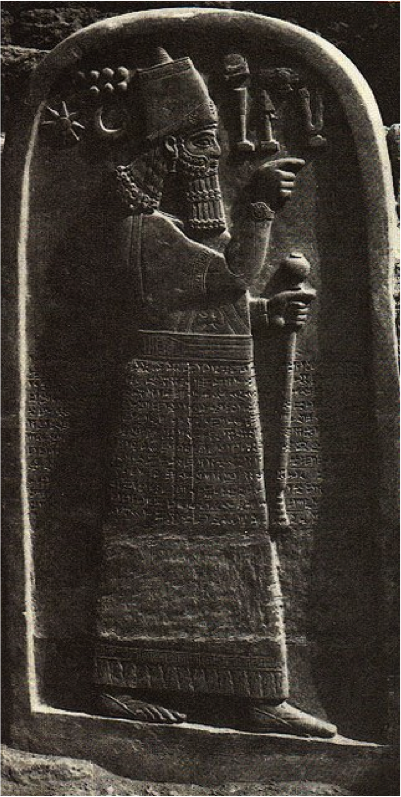
Iraq Museum, Baghdad
The Prophet Jonah, c. 760 BCE
Jonah 1:1-2
The word of the L-RD came to Jonah son of Amittai:
Go at once to Nineveh, that great city, and proclaim judgment upon it; for their wickedness has come before Me.
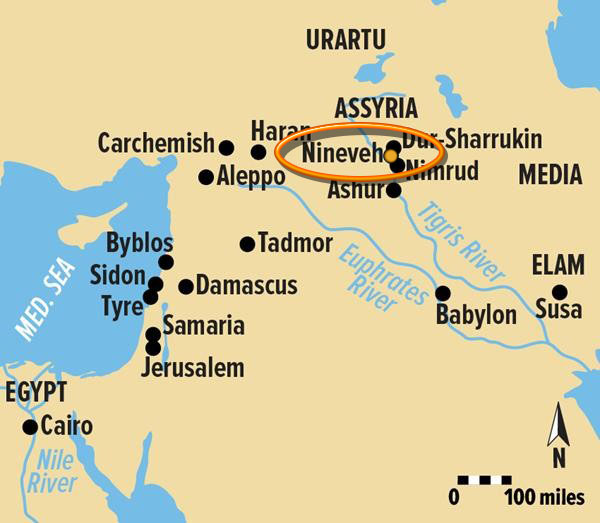
The Bible relates the story of the Prophet
Jonah (circa 760 BCE), who received a prophecy from G-d regarding the
destruction of Nineveh, should the king and the city refuse to repent.
Jonah 1:1-2 The
word of the L-RD came to Jonah son of Amittai:Go at once
to Nineveh, that great city, and proclaim judgment upon it; for their
wickedness has come before Me.
Trying to escape G-d's charge, Jonah boards a
ship for Tarshish. G-d casts a mighty storm that almost destroys the ship.
Jonah confesses to the sailors that he has brought this misfortune upon them,
and if they cast him overboard, the sea will calm down.
“And they heaved Jonah overboard, and the sea
stopped raging.” (Jonah 1:15)
There, a big fish swallows Jonah and after
Jonah’s repentance, the fish spits him out on the shore. Jonah delivers the
prophecy to the King of Nineveh and the city repents.
The Assyrian city of Nineveh is located in modern-day
northern Iraq, in the Kurdish city of Mosul.
The Assyrian city of Nineveh is located in the Kurdish area of northern Iraq, in the city of Mosul, 200 miles north of Baghdad.
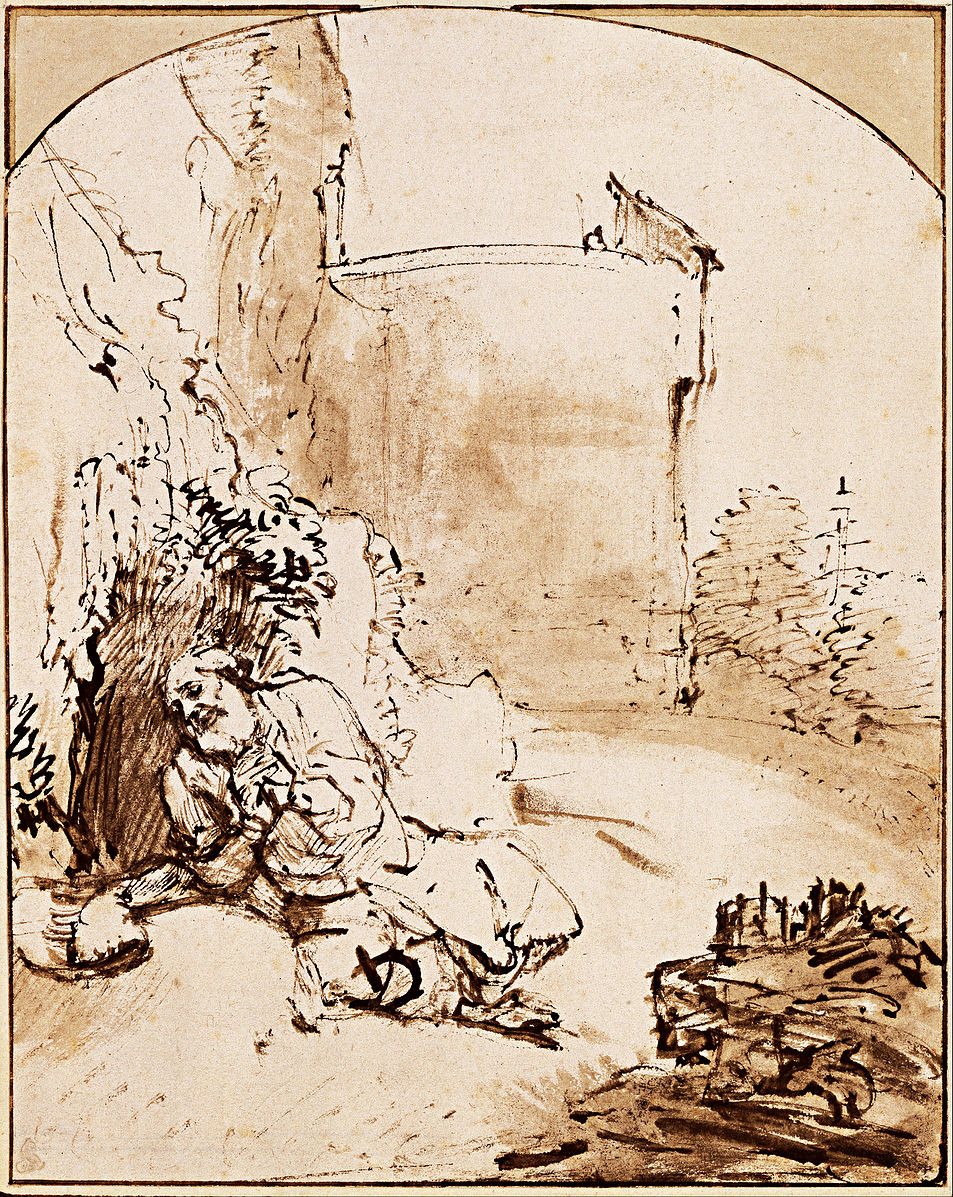
The Prophet Jonah before the Walls of Nineveh by Rembrandt
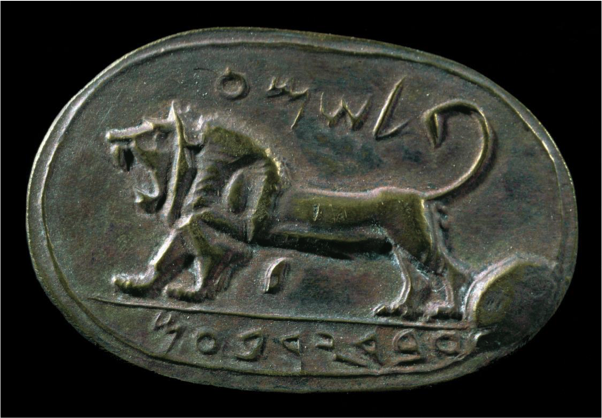
Bronze cast of the original jasper seal found in Megiddo in 1904, Israel Museum
King Jeroboam II of Israel,
r. 786–746 BCE
2 Kings 14:23
“In the fifteenth year of King Amaziah son of Joash of Judah, King Jeroboam (II) son of Joash of Israel became king of Samaria – for forty one years.”
Seal of Shema
“Belonging to Shema, Servant of Jeroboam (II) ”
In this picture is an impression of a seal
showing a figure of a roaring lion bearing the Hebrew inscription: (לשמע - עבד ירובם) meaning "Belonging to Shema, servant
of Jeroboam". It refers to Jeroboam II, King of Israel who ruled from
786–746 BCE.
2 Kings 14:23 “In
the fifteenth year of King Amaziah son of Joash of Judah, King Jeroboam (II)
son of Joash of Israel became king of Samaria – for forty-one years.”
The original jasper seal was found in the 1904
excavations at Megiddo. The seal itself was lost en route to the Istanbul
Museum, but fortunately, this impression cast in
bronze had been made prior to its shipment.

Portrait of Isaiah by Michelangelo, Sistine Chapel
Isaiah Begins His Prophecy,
c. 745 BCE
Isaiah 1:1
The prophecies of Isaiah son of Amoz, who prophesied concerning Judah and Jerusalem in the reigns of Uzziah, Jotham, Ahaz, and Hezekiah, kings of Judah.
Isaiah begins his prophecy circa 745 BCE.
The Prophet Isaiah, one of the
most known and beloved amongst the prophets, starts his prophecy during the
time when the Assyrians reassert their intimidating power on the geopolitical
map.
He not only warns of destruction and exile, should Judah and Israel
continue in their idolatrous descent, but he is most well-known for his message
to encourage righteousness
and justice, and prophecies of consolation
and hope, speaking of a time in the distant future when the nation of Israel
will again return to their borders.
His prophecy covers the period of Assyrian
aggression by Kings Tiglath-Pileser III, Sargon II, and Sennacherib.
The Assyrian attacks ultimately result in the destruction
of the ten northern tribes of Israel as well as the Siege of Jerusalem.

Isaiah begins his prophecy as Tiglath-pileser
III, also known as King Pul of Assyria wages war with Israel and Judah, in 745
BCE.
Isaiah 1:1
The
vision of Isaiah the son of Amoz, which he saw concerning Judah and Jerusalem,
in the days of Uzziah, Jotham, Ahaz, and Hezekiah, kings of Judah.
Click the link to view the Great Isaiah
Scroll, one of the original seven Dead Sea Scrolls discovered in Qumran in 1947
by a shepherd boy, and purchased by the Israeli government in November of that
year, the same month that the United Nations voted in favor of the creation of
the State of Israel. It is the largest and most well-preserved of all the
biblical scrolls and the only one that is almost complete.
You can also virtually scroll and zoom into the
ultra-high resolution digitized version of the Great Isaiah Scroll photographed
by Ardon Bar-Hama for the Israel Museum courtesy of George Blumenthal and
Google.
The Digital Dead Sea Scrolls, Israel Museum and Google
Photography by Ardon Bar-Hama, Courtesy of George Blumenthal
The Great Isaiah Scroll
Isaiah begins his prophecy as Tiglath-pileser III (Pul) of Assyria wages war with Israel and Judah, 745 BCE.
visit site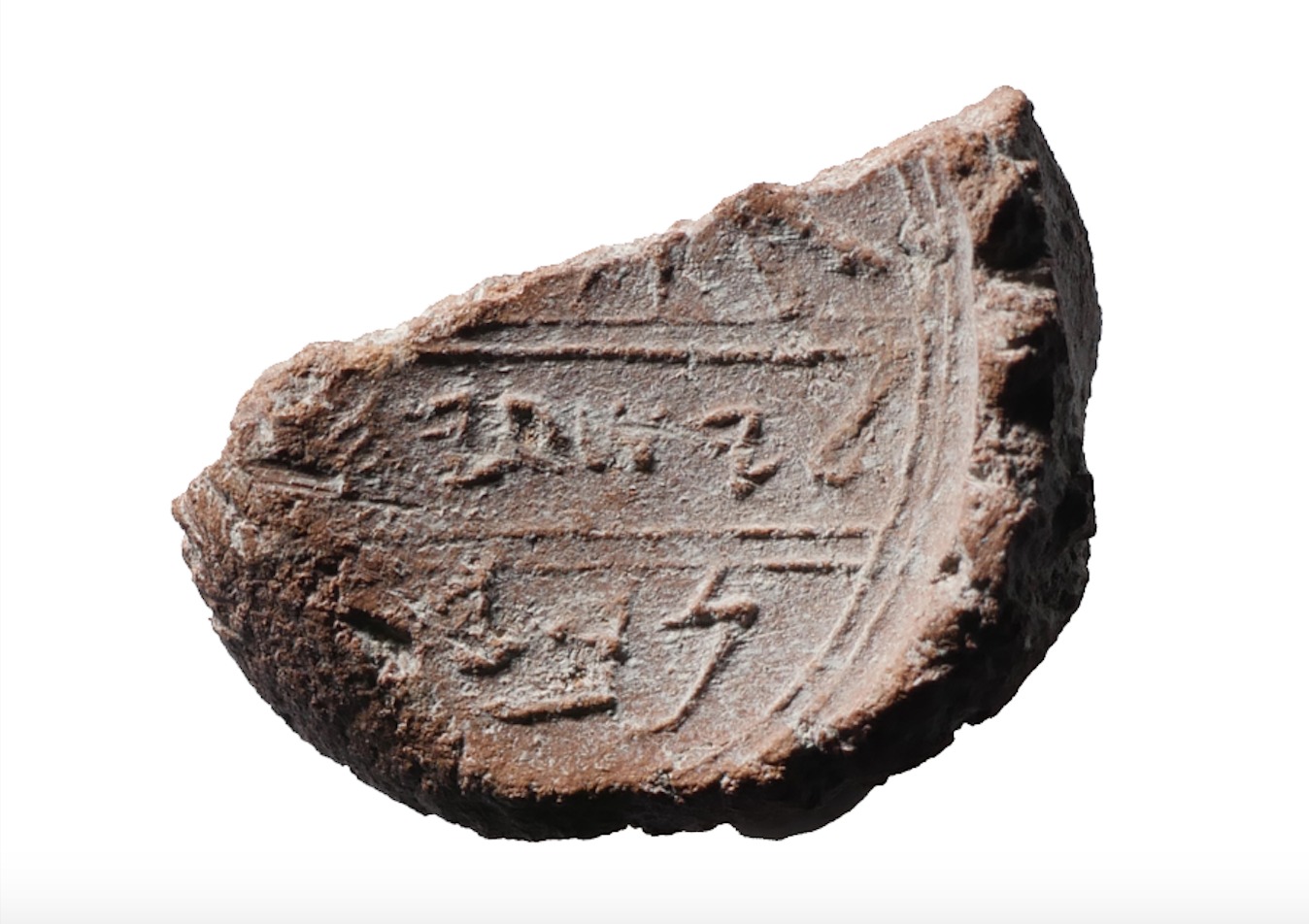
The Seal Impression of Isaiah
c. 745-686 BCE
Isaiah 1:1
The prophecies of Isaiah son of Amoz, who prophesied concerning Judah and Jerusalem in the reigns of Uzziah, Jotham, Ahaz, and Hezekiah, kings of Judah.
Found in 2015 by Eilat Mazar and the Ophel Excavations at the Southern Wall of the Temple Mount, the seal impression is inscribed with the name “Yesha‘yah[u],” Hebrew for “Isaiah,” followed by the word “nvy.” Part of the seal is broken off, but “nvy” might be an incomplete word that was once followed by the Hebrew letter aleph. If so, the seal would spell out the Hebrew word for prophet.
The Seal of Isaiah the Prophet
circa 745-686 BCE
In this picture is a clay seal impression or
bulla, that was found in 2015 by archaeologist Dr. Eilat Mazar during the Ophel
Excavations at the Southern Wall of the Temple Mount. The seal is inscribed
with the name “Yesha‘yah[u],” Hebrew for “Isaiah,” followed by the letters
nun-bet-yud. Part of the seal is broken off, but these three letters might be
an incomplete word that was once followed by the Hebrew letter aleph. If so,
the seal would spell out [נביא] the Hebrew word for prophet.
Israel Museum, Jerusalem / Israel Antiquities Authority
Photo by Ouria Tadmor / Eilat Mazar
"Belonging to Amotz"
I saiah 2:1-2
The word
that Isaiah the son of Amoz saw concerning Judah and Jerusalem. And it shall
come to pass in the end of days, that the mountain of the L-RD'S house shall be
established as the top of the mountains and shall be exalted above the hills;
and all nations shall flow unto it.
This 8th Century BCE sherd from a jar is inscribed "Belonging to Amotz," the same name as Isaiah's father.
This 8th Century BCE sherd from a jar is
inscribed "Belonging to Amotz," the same name as Isaiah's
father.
The inscription was found in 1966 in the first
year of the excavation at Tel Dan in the Northern Galilee.
Isaiah 2:1-2
The word
that Isaiah the son of Amoz saw concerning Judah and Jerusalem. And it shall
come to pass in the end of days, that the mountain of the L-RD'S house shall be
established as the top of the mountains and shall be exalted above the hills;
and all nations shall flow unto it.
Avraham Biran and Hebrew Union College-Jewish Institute of Religion
King Uzziah of Judah,
r. 783-742 BCE
2 Chronicles 26:3
Uzziah was sixteen
years old when he became king, and he reigned fifty-two years in Jerusalem
Epitaph of King Uzziah
“The bones of Uzziah King of Judah”
The first reign that Isaiah mentions is that
of King Uzziah. King Uzziah of Judah
reigned in the middle of the 8th Century BCE. However, the inscribed epitaph here dates to
a much later time period, indicating that this plaque was used to mark the
reburial of his remains. The Bible notes
that King Uzziah was a leper until his death, therefore he may have originally
been buried in a special location due to the stigma of impurity associated with
the disease.
The Epitaph of King Uzziah reads: “To
this place were brought the bones of Uzziah, the king of Judah — do not open!”
2 Chronicles 26:3 Uzziah was sixteen years old when he became king, and he reigned
fifty-two years in Jerusalem.
Israel Museum, Jerusalem / Israel Antiquities Authority , Photo by Meidad Suchowolski
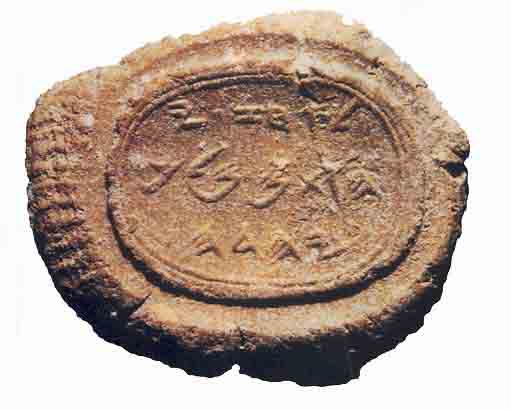
Shlomo Moussaieff Collection, London
King Ahaz of Judah
r. 732-716 BCE
Isaiah 1:1
The prophecies of Isaiah son of Amoz, who prophesied concerning Judah and Jerusalem in the reigns of Uzziah, Jotham, Ahaz, and Hezekiah, kings of Judah.
Tiglath-Pileser III Building Inscription
"[I received] the tribute of... (Jeho)Ahaz of Judah..."
King Ahaz Seal Impression
“ Belonging to Ahaz (son of) Yehotam, King of Judah,”
Another king mentioned by Isaiah is King Ahaz
of Judah, who ruled from 732-716 BCE.
2 Chronicles 28:1 says,
“Ahaz
was twenty years old when he became king, and he reigned sixteen years in
Jerusalem. He did not do what was pleasing to the L-RD as his father David had
done.”
This clay bulla, found in 1995, contains a
Hebrew inscription that reads, “Belonging
to Ahaz (son of) Yehotam, King of Judah.”
King Hezekiah of Judah,
r. 715-687 BCE
Isaiah 1:1
The prophecies of Isaiah son of Amoz, who prophesied concerning Judah and Jerusalem in the reigns of Uzziah, Jotham, Ahaz, and Hezekiah, kings of Judah.
Hezekiah Seal Impression
Found in 2015 by Eilat Mazar and the Ophel Excavations at the Southern Wall of the Temple Mount.
“Belonging to Hezekiah, (son of) Ahaz, King of Judah.”
The final king mentioned in the opening verse
of Isaiah is King Hezekiah of Judah, reigning from 715-687 BCE.
2 Kings 18:1 records, “In
the third year of King Hoshea son of Elah of Israel, Hezekiah son of King Ahaz
of Judah became king.
The Book of Kings goes on to say that Hezekiah “did
what was pleasing to the L-RD, just as his father David had done.”
In 2015, this seal impression of Hezekiah was found
at
the Southern Wall of the Temple Mount,
reading: “Belonging
to Hezekiah, (son of) Ahaz, King of Judah.”
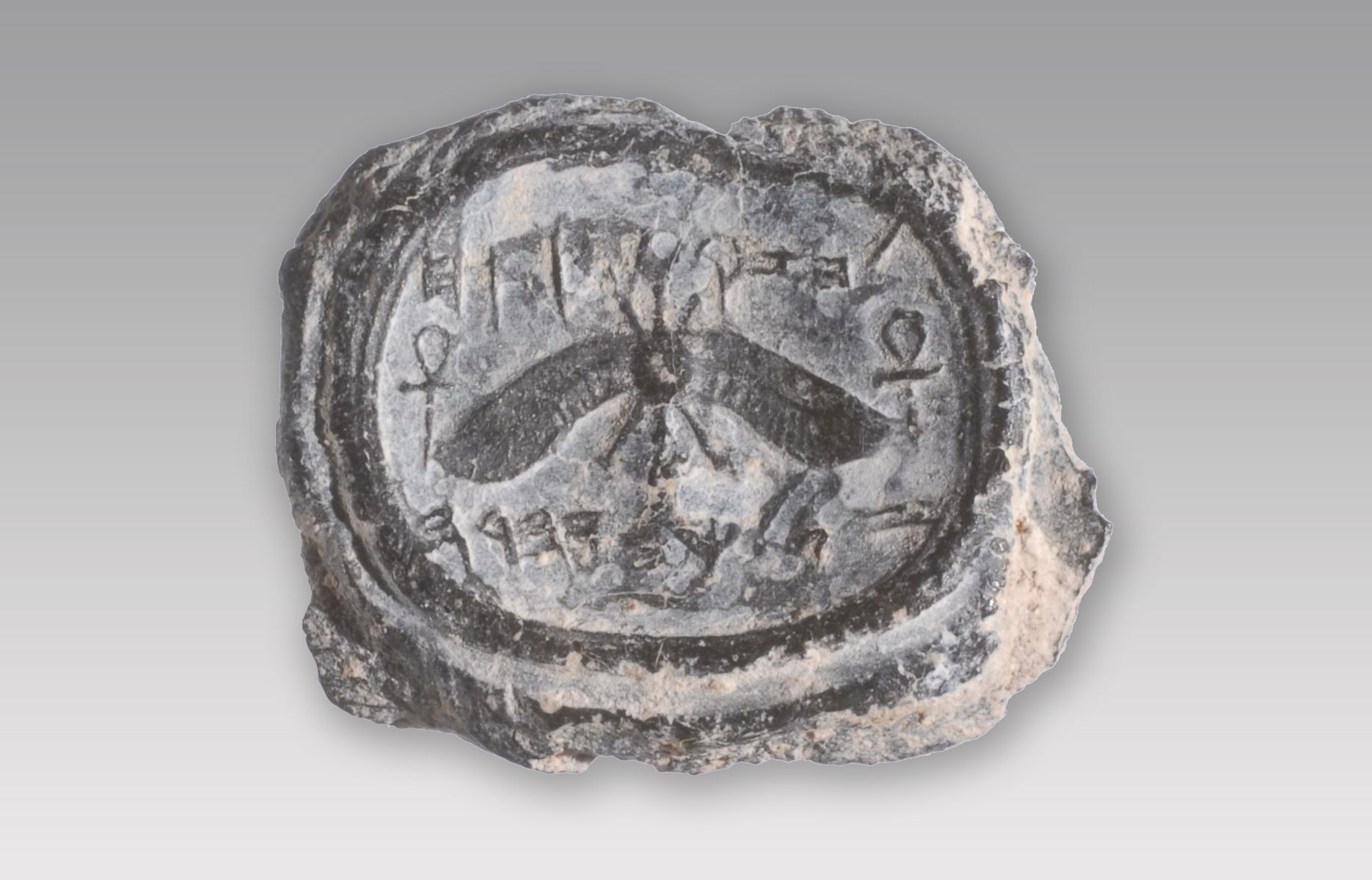
Israel Antiquities Authority / Israel Museum, Photo by Peter Lanyi
The Prophet Isaiah and the Assyrian Kings
The Northern Kingdom of Israel, consisting of
the Northern 10 Tribes, was conquered and systematically exiled during this
period by four Assyrian monarchs Tiglath-Pileser III, Shalmaneser V, Sargon II,
and finally Sennacherib.
The Prophet Isaiah foresaw and announced
destruction by the Assyrian Kings.
Isaiah 10: 5-6
Ha,
Assyria, rod of My anger. In whose hand, as a staff is My fury! I send him
against an ungodly nation, I charge him against a people that provoke Me, to
take its spoil and to seize its booty and to make it a thing trampled like the mire
of the streets.
The Digital Dead Sea Scrolls, Israel Museum and Google Photography by Ardon Bar-Hama, Courtesy of George Blumenthal

King Menahem of Israel,
r. 745-738 BCE, and
Tiglath-Pileser III (Pul), King
of Assyria, r. 745-727 BCE
2 Kings 15:19-20
Menahem gave Pul a thousand talents of silver... every man of means had to pay fifty shekels of silver for the king of Assyria.
Iran Stele, 738 BCE
“ I (Tiglath-pileser III) received tribute from . . . Menahem of Samaria.”
Tiglath-Pileser III was the architect of the Neo-Assyrian
Empire’s most extensive westward expansion.
His troops swept toward the Mediterranean Sea encountering Israel and
cities in Lebanon and Judah. He recorded
his military campaigns and conquests on the Iran Stele, pictured here, circa
738 BCE.
One of the sections of the inscription records
a list of kings who paid tribute to Tiglath-Pileser III including “Menahem of
Samaria,”. The Inscription reads as follows: “ I
(Tiglath-Pileser) received tribute from . . . Menahem of Samaria.”
“Samaria” refers to the capital of the
Northern Kingdom of Israel.
This corroborates with the biblical account in
which the Israelite King Menahem paid a large tribute to Tiglath-Pileser, who
is known as “Pul” in the Bible.
2 Kings 15:19-20 Menahem
gave Pul a thousand talents of silver... every man of means had to pay fifty
shekels of silver for the king of Assyria.
Israel Museum, Jerusalem, Photo by Ardon Bar-Hama
The Tribe of Naphtali and Tiglath-Pileser III (Pul)
2 Kings 15:29
In the days of King Pekah of Israel (c. 740-732 BC), King Tiglath-pileser of Assyria came and captured…Hazor and Gilead and Galilee, all the land of Naphtali; and he deported the inhabitants to Assyria.
The Annals of Tiglath-Pileser III
“…Israel (Bit Hu-um-ri-a, "House of Omri") and the wide land of Naphtali, in its entire extent, I united with Assyria."
In 1873, British Explorer Sir Austen Henry
Layard discovered Tiglath Pileser's palace at Nimrud (ancient Kalhu) near the
city of Mosul in north-eastern Iraq. He discovered multiple inscriptions that
were summary statements of Tiglath Pileser III’s accomplishments. One of which
mentions the Israelite House of Omri, and the land of the Tribe of Naphtali.
One of the sections read: “…Israel
(Bit Hu-um-ri-a, or the "House of Omri") and the wide land of
Naphtali, in its entire extent, I united with Assyria."
It corresponds directly with the Biblical
account:
2 Kings 15:29
In the
days of King Pekah of Israel, King Tiglath-Pileser of Assyria came and
captured…Hazor and Gilead and Galilee, all the land of Naphtali; and he
deported the inhabitants to Assyria.
Wikimedia Commons
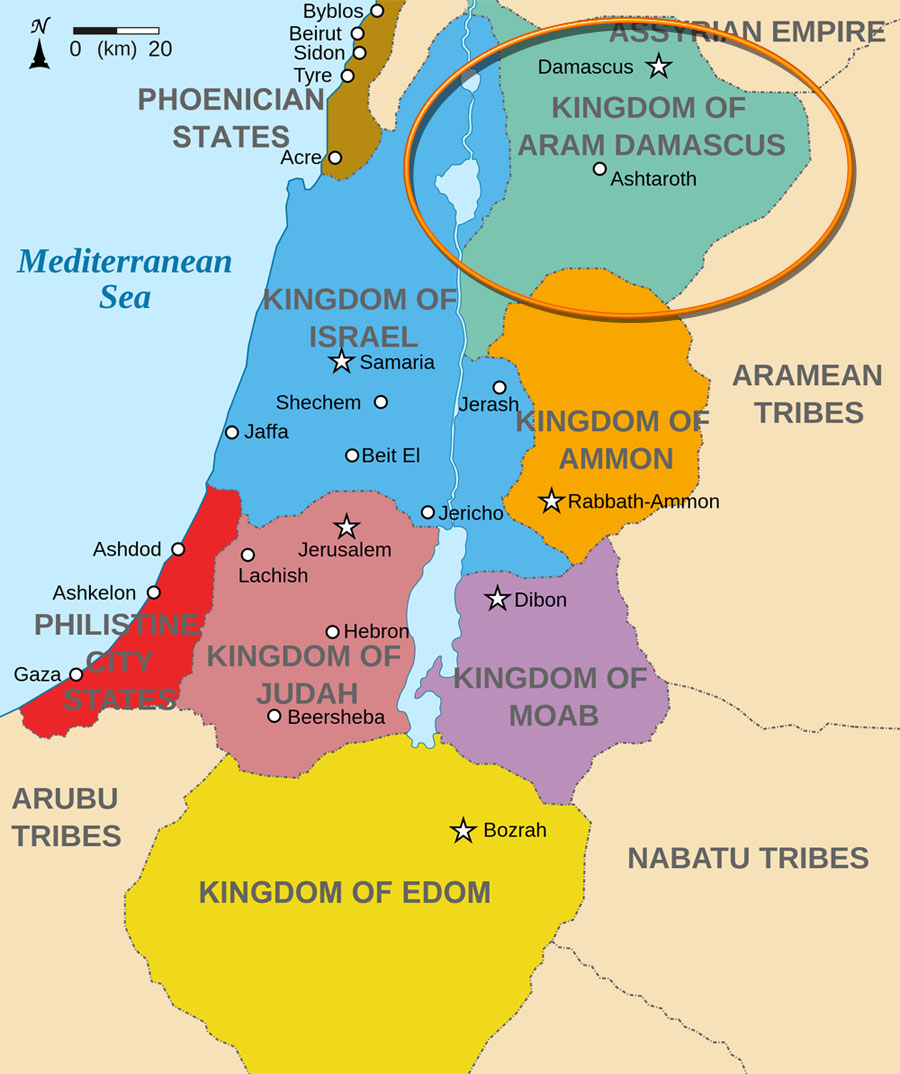
Tiglath-Pileser III (Pul) Defeats King Rezin of Damascus,
732 BCE
Isaiah 8:4-6
...the riches of Damascus and the spoil of Samaria shall be carried away before the king of Assyria. And the L-RD spoke unto me yet again, saying: Forasmuch as this people refused the waters of Shiloah that go softly, and rejoice with Rezin and Remaliah's son;
The Calah Annals of Tiglath-Pileser III
“…Rezin the Damascene I captured heavy booty I impaled alive his chief ministers…”
After many years of paying heavy levies,
Israel and Judea as well as Damascus (in modern Syria) openly rebelled against
the Assyrians by refusing to pay. The Assyrians, under Tiglath Pileser III, set
siege to Damascus and killed its king, Rezin.
The Kalhu Annals of Tiglath-Pileser III that
were found in Nimrud give a further account of this:
“…Rezin
the Damascene I captured,,, heavy booty, I impaled alive his chief ministers…”
This corroborates with the Book of Isaiah 8:4-6
...the riches of Damascus and the spoil of Samaria shall be carried away before the king of Assyria. And the L-RD spoke unto me yet again, saying: Forasmuch as this people refused the waters of Shiloah that go softly, and rejoice with Rezin and Remaliah's son;
Wikimedia Commons
Relief from the palace of Tiglath-Pileser III (Pul)
A panel from the palace of Tiglath-pileser III depicts Israelite captives from Astartu, as identified in the inscription, which was a fortified town in northern Galilee (East of the Sea of Galilee).
In this photo by Ardon Bar-Hama is a section of the relief from the palace of Tiglath-pileser III at Nimrud, currently on display in the British Museum, depicting Israelite captives from Astartu, as identified in the inscription, which was a fortified town in northern Galilee.
The British Museum, London, Photo by Ardon Bar-Hama
King Hoshea of Israel,
r. 732-723 BCE
2 Kings 17:1
In the twelfth year of Ahaz king of Judah, Hoshea the son of Elah became king over Israel in Samaria, and reigned nine years.
The Calah Annals of Tiglath-Pile ser III
"They [the Israelites] overthrew their king Pekah and I placed Hoshea as king over them."
Seal of Abdi
“Belonging to Abdi, servant of Hoshea”
2 Kings 17:1 In the
twelfth year of Ahaz king of Judah, Hoshea the son of Elah became king over
Israel in Samaria and reigned nine years.
King Hoshea of Israel, ruled from 732-723 BCE
and was the last King of the Northern kingdom.
The Bible records:
“King Shalmaneser (the fifth) of Assyria
marched against him, and Hoshea became his vassal and paid him tribute.” 2 Kings 17:3
In this picture is the Seal of Abdi, a servant
of King Hoshea. The seal reads: “Belonging to Abdi, servant of Hoshea”
Shlomo Mousaieff Collection, London

The British Museum, London
Sargon II, King of Assyria, Captures Samaria, 720 BCE
2 Kings 17:6
In the ninth year of Hoshea, the king of Assyria captured Samaria. He deported the Israelites to Assyria.
Nimrud Prism, Annals of Sargon II
“I besieged and conquered Samaria, led away as booty 27,290 inhabitants of it.”
In 720, Sargon II, King of Assyria (r. 722-705 BCE), led an attack on Samaria, the region of the 10 Northern Tribes of Israel. He took many Israelites to Nimrud (Iraq) as slaves, while other Israelites fled to Jerusalem.
In 720 BCE, Sargon II, King of Assyria that
ruled from 722-705 BCE, captured Samaria, the region of the 10 Northern Tribes
of Israel. He took many Israelites to Nimrud (Iraq) as slaves, while other
Israelite refugees fled to Jerusalem.
He
recorded this conquest in his annals on the Nimrud Prism, which reads:
“I
besieged and conquered Samaria, led away as booty 27,290 inhabitants of it.”
The Bible confirms this account in 2 Kings
17:6:
In the
ninth year of Hoshea, the king of Assyria captured Samaria. He deported the
Israelites to Assyria.
Captured Israelites Are Taken to Nimrud, The Capital City of Sargon II of Assyria, 720 BCE
An 8th Century BCE ostracon found at Nimrud contains Biblical Hebrew names written in Aramaic. In conventional English, these names are: Michael, Menahem, Elisha, Hanan, Shubael, Uzziah, Hazael, Haggai, Achbor and Hananeel.
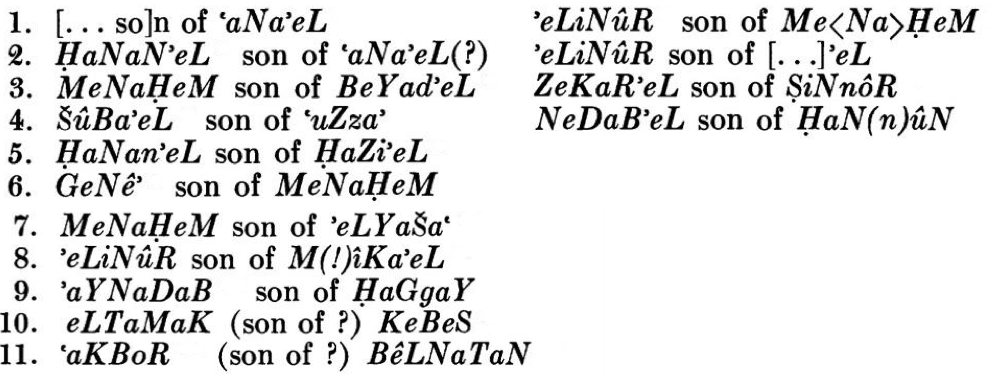
The captured Israelites were taken to Nimrud,
the Capital City of Sargon of Assyria circa 720 BCE
An 8th Century BCE ostracon found at Nimrud contains
Biblical Hebrew names written in Aramaic.
In conventional English, these names are: Michael, Menahem, Elisha,
Hanan, Shubael, Uzziah, Hazael, Haggai,
Achbor and Hananeel.
W. F. Albright
Temple at Arad,
8th Century BCE
2 Kings 18:3-4
He (Hezekiah) did what was pleasing to the L-RD, just as his father David had done. He abolished the shrines and smashed the pillars and cut down the sacred post…
A small sanctuary was uncovered in the Arad fortress on Judah’s southern border. It is the only Judahite temple ever discovered. The sanctuary was intentionally buried in the time of King Hezekiah, who sought to abolish all public worship outside the Temple in Jerusalem.
Hezekiah became king of Judah in 715 BCE. He instituted a number of religious
reforms.
2 Kings 18:3-4 records
He
(Hezekiah) did what was pleasing to the L-RD, just as his father David had
done. He abolished the shrines and smashed the pillars and cut down the sacred
post…
Supporting this biblical account, a small
sanctuary dating back to the 8th Century BCE was uncovered in the Arad fortress
on Judah’s southern border. It is the only Judahite temple ever
discovered. The sanctuary was
intentionally buried in the time of King Hezekiah, who sought to abolish all
public worship outside the Temple in Jerusalem.
Israel Museum / Israel Antiquities Authority
Sennacherib, King of Assyria, r. 705–681 BCE, Invades Judah
2 Chronicles 32:1
Sennacherib king of Assyria came and invaded Judah. He laid siege to the fortified cities, intending to conquer them for himself.
After the systematic exile of the Northern
Tribes by his predecessors, Sennacherib, King of Assyria invaded Judah.
Sennacherib ruled from 705 to 681 BCE.
2 Chronicles 32:1 Sennacherib
king of Assyria came and invaded Judah. He laid siege to the fortified cities,
intending to conquer them for himself.

The Route of Sennacherib’s Campaigns
Biblical Archaeology Society
King Hezekiah Prepares to Battle the Sennacherib,
701 BCE
2 Chronicles 32:2-4
When Hezekiah saw that Sennacherib had come, intent on making war against Jerusalem, he consulted with his officers and warriors about stopping the flow of the springs outside the city…. A large force was assembled to stop up all the springs and the wadi that flowed through the land, for otherwise, they thought, the king of Assyria would come and find water in abundance.
Hezekiah prepared the city for the siege by shutting off the water supply outside the city, diverting water from the Gihon spring into an underground tunnel.
King Hezekiah was well aware of
Sennacherib’s invasion of Judea and began significant preparations in
Jerusalem to withstand an Assyrian onslaught. The Bible provides a detailed
account:
2 Chronicles 32:2-4 When
Hezekiah saw that Sennacherib had come, intent on making war against
Jerusalem, he consulted with his officers and warriors about stopping the
flow of the springs outside the city….
A large force was assembled to stop up all the springs and the wadi
that flowed through the land, for otherwise, they thought, the king of
Assyria would come and find water in abundance.
Water
played a central role in the conquest of a city in ancient times. Not only
did the approaching army try to cut off the inhabitants from their water
source, but they also needed it for their own armies. Hezekiah prepared the
city for the siege by shutting off the water supply outside the city,
diverting water from the Gihon spring through an underground tunnel to a pool
within the city’s confines.
Hershel Shanks, Founder of Biblical Archaeology Review, exploring Hezekiah's Tunnel, Photo by Zev Radovan
King Hezekiah Builds the Siloam Tunnel to Protect Jerusalem’s Water Supply from the Assyrians
2 Chronicles 32:30
“It was Hezekiah who blocked the upper outlet of the Spring of Gihon and channeled it down to the west side of the City of David. And Hezekiah prospered in all that he did.”
2 Chronicles 32:30 “It
was Hezekiah who blocked the upper outlet of the Spring of Gihon and channeled
it down to the west side of the City of David. And Hezekiah prospered in all
that he did.”
Watch the video by the Megalim Institute on the
construction of the legendary Hezekiah’s tunnel, courtesy of George Blumenthal
and the Gol Family
City of David Megalim Institute, Courtesy of George Blumenthal and the Gol Family
2 Kings 20:20
The other events of Hezekiah’s reign, and all his exploits, and how he made the pool and the conduit and brought the water into the city, are recorded in the Annals of the Kings of Judah.
2 Kings 20:20
The
other events of Hezekiah’s reign and all his exploits, and how he made the pool
and the conduit and brought the water into the city, are recorded in the Annals
of the Kings of Judah.
In this picture, you can see the cross-section of the
City of David showing the path of the tunnel running underneath the city.
Tower of David Museum, Jerusalem
The Siloam Tunnel Inscription From
Hezekiah's Tunnel,
The Oldest Hebrew Text, 701 BCE
“The tunneling was completed... While the hewers wielded the ax, each man toward his fellow... there was heard a man's voice calling to his fellow... the hewers hacked each toward the other, ax against ax, and the water flowed from the (Gihon) spring to the (Siloam) pool, a distance of 1,200 cubits...”

Replica of the Shiloah Inscription, Photo by Zev Radovan, City of David Archives
Original inscription is at the Istanbul Archaeology Museum
Pictured here is a replica of the Siloam
Tunnel Inscription from Hezekiah's Tunnel, the Oldest Hebrew Text dating back
to 701 BCE. The inscription describes
the digging of the tunnel by two crews of workmen working from opposite ends to
meet in the middle. It was discovered
carved into the tunnel wall in 1880 by boys playing near the southern end of
the tunnel.
Although it was naturally carved into the tunnel wall, thieves
chiseled it out of the wall, breaking it into pieces. The original inscription
is currently on display at the Istanbul Archaeology Museum.
The Inscription reads: “The
tunneling was completed... While the hewers wielded the ax, each man toward his
fellow... there was heard a man's voice calling to his fellow... the hewers
hacked each toward the other, ax against ax, and the water flowed from the (Gihon)
spring to the (Siloam) pool, a distance of 1,200 cubits...”
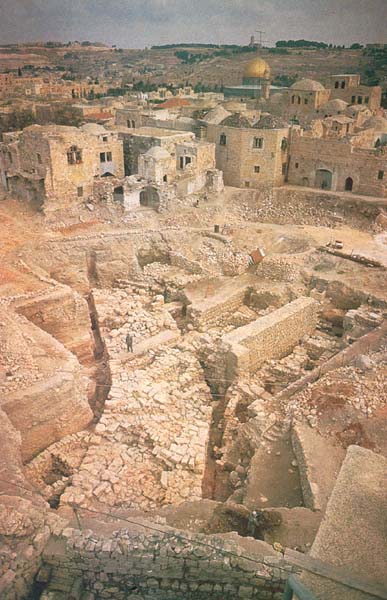
Israel Antiquities Authority, Photo by Nahman Avigad
King Hezekiah Prepares to Battle the Sennacherib, 701 BCE
Isaiah 22:10
[Hezekiah] counted the houses of Jerusalem and tore them down to strengthen the wall.
The Assyrian conquest of the Northern Kingdom of Israel led refugees to flee to Jerusalem and build homes there. King Hezekiah of Judah, in preparation for the coming of the Assyrians, fortified the wall of Jerusalem, building the Broad Wall around the entire city. The Broad Wall was unearthed in the 1970s by Israeli archaeologist Nahman Avigad.
The Assyrian conquest of the Northern Kingdom
of Israel led refugees to flee to Jerusalem and build homes on the outskirts of
the city. Along with building the tunnel
to divert the water, King Hezekiah of Judah prepared for the coming Assyrians
by fortifying the wall of Jerusalem and building the Broad Wall to include and
protect the expanding city.
Isaiah recorded in verse 22:10:
[Hezekiah]
counted the houses of Jerusalem and tore them down to strengthen the wall. In the 1970s, the Broad Wall was unearthed by
Israeli archaeologist Nahman Avigad. A section can be viewed today in the
Jewish Quarter of the Old City.
City of David Megalim Institute, Courtesy of George Blumenthal and the Gol Family
The Broad Wall of
King Hezekiah
2 Chronicles 32:5
He (Hezekiah) acted with vigor, rebuilding the whole breached wall, raising towers on it, and building another wall outside it. He fortified the Millo of the City of David, and made a great quantity of arms and shields.
2 Chronicles 32:5 He
(Hezekiah) acted with vigor, rebuilding the whole breached wall, raising towers
on it, and building another wall outside it. He fortified the Millo of the City
of David and made a great number of arms and shields.
Watch the video by the City of David Megalim Institute
expounding on the construction of the Broad Wall, courtesy of George Blumenthal
and the Gol Family
King Sennacherib of Assyria Attacks the City of Lachish, 701 BCE
2 Chronicles 32:9
Later, as Sennacherib king of Assyria and all his forces besieged Lachish, he sent his servants to Jerusalem with a message for King Hezekiah of Judah and all the people of Judah who were in Jerusalem.
Inscription from Sennacherib’s Palace at Nineveh
“Sennacherib, king of the universe, king of Assyria, seated upon a sedan chair, the spoils of Lachish passed before him.”
The central battle in Sennacherib’s campaign
against Judah was at Lachish in 701 BCE.
Lachish was an important fortress city, located 25 miles southwest of
Jerusalem.
Amazingly, Sennacherib
recreated in great detail scenes from the merciless battle on reliefs that
adorned the walls of his “Palace without Rival” in Nineveh. The Lachish Reliefs are currently on display
in the British Museum in London.
Part of the inscription from Sennacherib’s
Palace at Nineveh reads:
“Sennacherib,
king of the universe, king of Assyria, seated upon a sedan chair, the spoils of
Lachish passed before him.”
2 Chronicles 32:9 Later, as
Sennacherib king of Assyria and all his forces besieged Lachish, he sent his
servants to Jerusalem with a message for King Hezekiah of Judah and all the
people of Judah who were in Jerusalem.
The British Museum, London
Photo by Ardon Bar-Hama
The Lachish Reliefs Depict the Battle of Lachish and the Deportation of Israelites in 701 BCE
Learn more about the Battle of Lachish in this Megallim Institute video, courtesy of George Blumenthal and the Gol Family.
City of David Megalim Institute, Courtesy of George Blumenthal and the Gol Family
In this panel of the Lachish Reliefs, Judean prisoners are depicted taking their families, goods, and animals with them into exile.
Judeans from Lachish Are Exiled to Assyria
Lachish Relief, The British Museum, London, Photo by Ardon Bar-Hama
Recreation of Lachish Reliefs in Sennacherib’s Palace in Nineveh
This video, created by the Institute for the Visualization of History courtesy of George Blumenthal, recreates Sannecherib’s palace in Nineveh, envisioning what it was like to walk through the palace to the Lachish Battle Room.
Institute for the Visualization of History, Courtesy of George Blumenthal
King Sennacherib at Lachish sends Rabshakeh to Jerusalem, c. 701 BCE
Isaiah 36:2-16
F rom Lachish, the king of Assyria sent the Rabshakeh, with a large force, to King Hezekiah in Jerusalem.
And the Rabshakeh stood and called out in a loud voice in Judean: “Hear the words of the Great King, the king of Assyria! ...
Don’t listen to Hezekiah. For thus said the king of Assyria: Make your peace with me and come out to me, so that you may all eat from your vines and your fig trees and drink water from your cisterns..."
King Sennacherib at Lachish sends Rabshakeh, a Jewish deserter who knew Hebrew,
to Jerusalem in 701 BCE, to start a psychological intimidation campaign,
mocking the Judeans’ trust in their G-d and king.
Isaiah 36:2-16 From
Lachish, the king of Assyria sent Rabshakeh, with a large force, to King
Hezekiah in Jerusalem. And
Rabshakeh stood and called out in a loud voice in Judean: “Hear the words of
the Great King, the king of Assyria! ... Don’t
listen to Hezekiah. For thus said the king of Assyria: Make your peace with me
and come out to me, so that you may all eat from your vines and your fig trees
and drink water from your cisterns..."
Sling Stones from the Battle of Lachish
Israel Antiquities Authority / Israel Museum, Photo by Neta Dror
King Hezekiah and Sennacherib
Isaiah 36:6
You are relying on Egypt, that splintered reed of a staff, which enters and punctures the palm of anyone who leans on it. That’s what Pharaoh king of Egypt is like to all who rely on him.
Sennacherib's Prism
He (Hezekiah) called upon the kings of Egypt. The bowmen, the chariots and the calvary of the King of Ethiopia... I fought with them and inflicted a defeat upon them... I personally captured alive the charioteers of the King of Ethiopia.
 View Verse in
View Verse in the Great Isaiah scroll
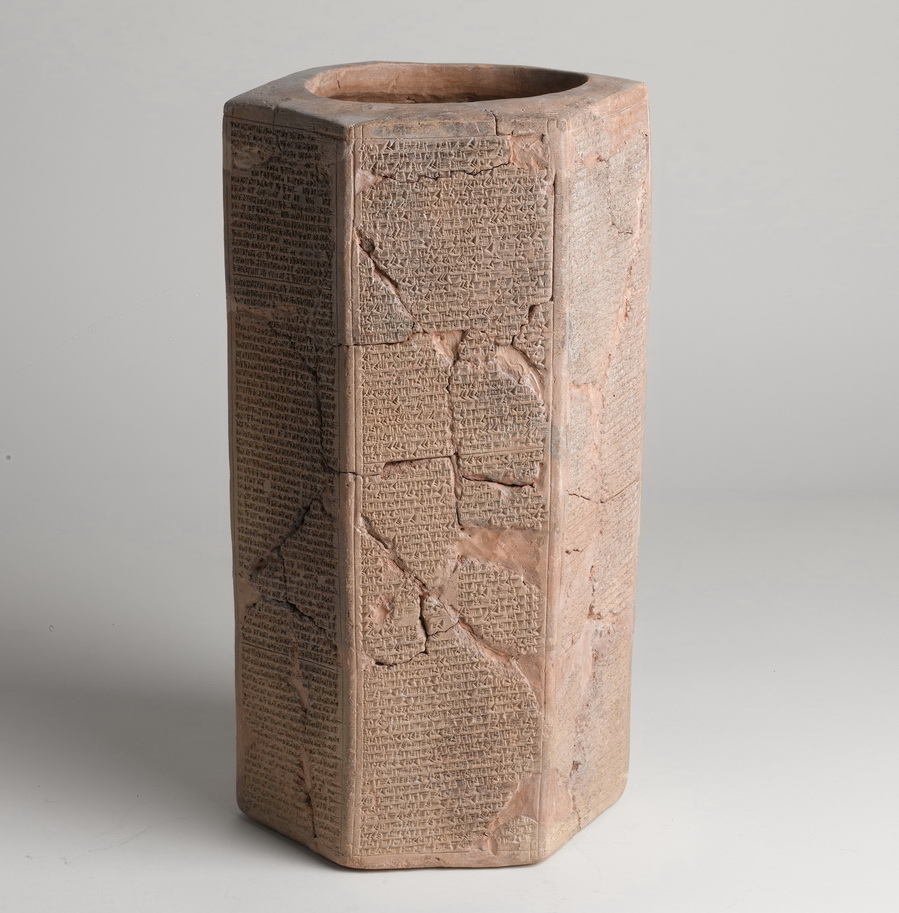
Sennacherib used different ways to chronicle
his war campaigns. The final versions were three prisms made of red baked clay
and hexagonal in shape inscribed in Akkadian script.
In the picture is the Jerusalem Prism, which
was dedicated to his campaigns against the Kingdom of Israel and the Kingdom of
Judah.
One of the sections reads as follows: He
(Hezekiah) called upon the kings of Egypt. The bowmen, the chariots, and the
cavalry of the King of Ethiopia... I
fought with them and inflicted a defeat upon them... I personally captured
alive the charioteers of the King of Ethiopia.
This inscription confirms Isaiah’s account in
36:6 of Rabshake’s intimidating speech during the besiegement:
You are
relying on Egypt, that splintered reed of a staff, which enters and punctures
the palm of anyone who leans on it. That’s what Pharaoh king of Egypt is like
to all who rely on him.
Israel Antiquities Authority / Israel Museum
Photo by Ardon Bar-Hama
Pharaoh of Egypt
Taharqa (Tirhakah)
2 Kings 19:8-9
The Rabshakeh, meanwhile, heard that the king had left Lachish; he turned back and found the king of Assyria attacking Libnah. But the king of Assyria learned that King Tirhakah of Nubia had come out to fight him
The Bible records Sennacherib’s encounter with
Egyptian Pharaoh Tirhakah in 2 Kings 19:9:
“But when
he (Sennacharib) heard that it is said about King Tirhakah, the King of Cush, that
he has come out to fight him…”
Tirhakah ruled over Egypt and the Kingdom of Cush in
Nubia, also known as Ethiopia, what is now Sudan and southern Egypt.
Kerma Museum, Sudan
King Sennacherib Withdraws from Jerusalem
2 Kings 19:35-36
That night an angel of the L-RD went out and struck down one hundred and eighty-five thousand in the Assyrian camp, and the following morning they were all dead corpses. So King Sennacherib of Assyria broke camp and retreated, and stayed in Nineveh.

As Sennacharib’s army reached Jerusalem,
Hezekiah turned to G-d in prayer. The Prophet Isaiah returns with G-d's
response.
Isaiah 37:33-35 Therefore,
thus says the L-RD concerning the king of Assyria: He shall not come unto this
city, nor shoot an arrow there, neither shall he come before it with shield,
nor cast a mound against it. By the way that he came, by the same shall he
return, and he shall not come unto this city, saith the L-RD. For I will defend
this city to save it, for My own sake, and for the sake of David, my servant.'
In a strange turn of events, the Assyrian camp
was hit by a divine plague.
2 Kings 19:35-36 That
night an angel of the L-RD went out and struck down one hundred and eighty-five
thousand in the Assyrian camp, and the following morning they were all dead
corpses. So, King Sennacherib of Assyria
broke camp and retreated, and stayed in Nineveh.
Sennacherib’s Palace Relief, The British Museum, London
Photo by Ardon Bar-Hama
The Death of Sennacherib: Esarhaddon Becomes King of Assyria, 681 BCE
Isaiah 37:38
While he [Sennacherib] was worshiping in the temple of his god Nisroch, he was struck down with the sword by his sons Adrammelech and Sarezer. They fled to the land of Ararat, and his son Esarhaddon succeeded him as king.
Babylonian Chronicle I
“On the twentieth day of the month Tebet, Sennacherib, king of Assyria, was killed by his son in a rebellion. On the twenty-eighth day of the month Adar Esarhaddon, his son, ascended the throne in Assyria.”
The end for Sennacherib would come at the hands of his sons. Isaiah writes in verse 37:38:
While he [Sennacherib] was worshiping in the temple
of his god Nisroch, he was struck down with the sword by his sons Adrammelech
and Sarezer. They fled to the land of Ararat, and his son Esarhaddon succeeded
him as king.
This
is confirmed in the Babylonian Chronicle, which reads: “On
the twentieth day of the month Tebet, Sennacherib, king of Assyria, was killed
by his son in a rebellion. On the twenty-eighth day of the month
Adar Esarhaddon, his son, ascended the throne in Assyria.”

Victory Stele of Esarhaddon, Pergamon Museum
Photo by Ardon Bar-Hama
The Tomb of Shebna, the Royal Steward
Isaiah 22:15-16
Thus says the L-RD G-D of hosts, "Come, go to this steward,
To Shebna, who is in charge of the royal household…
You have hewn a tomb for yourself here,
You who hew a tomb on the height,
You who carve a resting place for yourself in the rock?"
In this picture is the Tomb marker presumed to
belong to Shebna, the Royal Steward.
In Isaiah 22:15-16, the royal steward Shebna,
appointed by King Hezekiah, is admonished for building himself too grandiose a
tomb.
Thus
says the L-rd G-D of hosts, "Come, go to this steward, To
Shebna, who is in charge of the royal household…You
have hewn a tomb for yourself here, You
who hew a tomb on the height,You who
carve a resting place for yourself in the rock?"
The British Museum, London, Photo by Ardon Bar-Hama
Visualizing Isaiah: The Book of Isaiah Envisioned through Archaeology from the Israel Museum
Archaeology has played a pivotal role in bringing the Book of Isaiah to life. Not only through the discovery of the ancient Great Isaiah Scroll in Qumran, but also through countless artifacts that are connected to its narrative. Click on the link below to see the Book of Isaiah Envisioned through Archaeology from the Israel Museum.
created with
WordPress Website Builder .